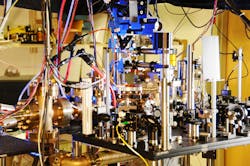Ytterbium clock sets stability record
A Ytterbium clock designed and built at the National Institute of Standards and Technology (NIST) is more stable than any other clock. (Stability is a measure of how precisely the duration of each tick matches every other tick.) The clock’s ticks are stable to within less than two parts in 1 quintillion (1018), which makes it 10 times more stable than previous atomic clocks. This will make the clock useful for measuring quantities such as magnetic fields, temperature, and gravity.
NIST has two such clocks, and each relies on approximately 10,000 ytterbium atoms cooled to 10 μKelvin (10 millionths of a degree above absolute zero). The atoms are trapped inside an optical lattice — a series of pancake-shaped wells made of laser light. A second laser pulses a beam 518 trillion times/sec into the lattice, causing a transition between two energy levels within the atoms, thus creating the clock ticks.
The key to getting the most accurate readings from an atomic clock is averaging its performance over time. For example, to get the most accurate results from the NIST-F1 cesium clock, the current U. S. civilian time standard, clock performance must be averaged over 400,000 sec (or about five days). The new ytterbium clock achieves the same level of accuracy after averaging its performance over the course of a single second.
The development of these clocks depended on the invention of an ultralow-noise laser to excite the atoms and the discovery of a way to cancel out disruptive effects caused by collisions between atoms. NIST now plans on more closely studying the new clock’s accuracy.

